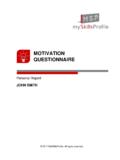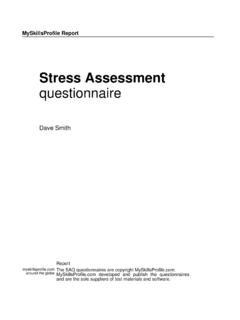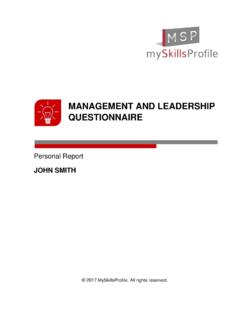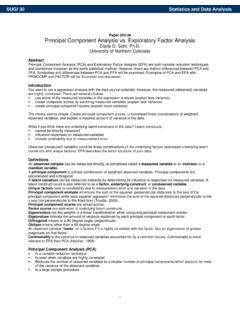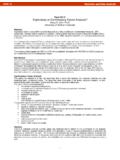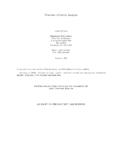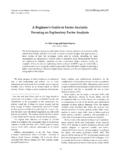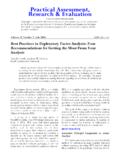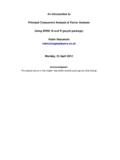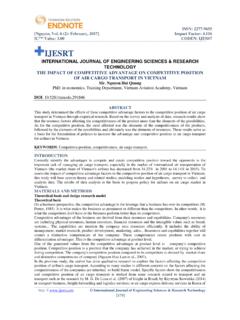Transcription of Creative Style Questionnaire - MySkillsProfile.com
1 Creative Style Questionnaire > User Manual 2 Copyright 2014, Limited. CSQ is a trademark of Limited. All rights reserved. No part of this publication may be reproduced or distributed in any form or by any means or stored in a database or retrieval system without the prior written permission of Limited. 3 Contents 1. Introduction .. 4 CSQ Model .. 4 Development of the CSQ .. 4 Comparison with Other Measures .. 6 Instrument Format .. 7 Quality Criteria .. 8 2. Administration .. 9 Applications .. 9 Test Administration .. 9 Norming .. 10 Good Practice .. 10 3. Scale Descriptions .. 11 Overview .. 11 Interpreting Scores .. 11 4. Reliability and 18 Internal Consistency 18 Scale Intercorrelations.
2 18 Standard Error of Difference .. 19 Factor Analysis .. 19 Relationship to Other Measures .. 23 Criterion-Related Validity .. 24 Demographics .. 26 5. 27 Age Distribution .. 27 Sector Characteristics .. 27 6. References .. 30 4 1. Introduction This user manual describes the development, administration, interpretation, and technical properties of the Creative Style Questionnaire (CSQ). It is available as a soft copy download only from MySkillsProfile. CSQ Model The CSQ assessment test measures five aspects of an individual s behavioral Style that affect how he or she thinks about issues, approaches problems, and generates ideas and solutions. The Questionnaire provides an overall score of Creative Style and scores on five facets of it. The instrument is a behavioral Style assessment test, and it does not measure cognitive ability.
3 Figure 1 illustrates the CSQ concept model. Figure 1. Dimensions of Creative Style Development of the CSQ The CSQ facet scales emerged from exploratory factor analysis of a prototype inventory that was designed to measure personality traits relevant to an individual s creativity and problem solving Style . We were influenced predominantly by research on the facets of the Openness factor in the literature on the Big Five personality factors, Creative Style Creating and Originating Challenging and Rsik Taking Adjusting and Changing Communicating and Selling Executing and Realizing 5 and Kirton s Adaptation-Innovation (AI) framework of cognitive Style (for example, Kirton, 2002). The development of the CSQ can be broken down into four phases. Phase 1. A prototype inventory was developed measuring fifteen personality traits.
4 These covered the Big Five factors of personality. Scales were constructed using items from the International Personality Item Pool (Goldberg, 2006) and items from the author s test item database. Scales contained equal numbers of positively and reverse-keyed items. Phase 2. The prototype inventory together with a feedback report was published and advertised as a free online assessment. The reliability of the scales was analyzed, norms were generated, and Exploratory Factor Analysis (EFA) was carried out to examine the factor structure of the inventory. EFA produced a rotated component matrix with five factors with five scales loading on the Openness factor. Two of the scales also loaded on two other factors Extraversion and Conscientiousness (Figure 2). Figure 2.
5 CSQ Creative Style Personality Factor Structure Phase 3. A second shorter instrument was developed using the five scales that loaded highest on the Openness factor. Some changes were made to items to improve the reliability of the scales. A new feedback report was developed focusing on Creative and innovative Style . The assessment was published online as a free assessment whilst we carried out further analysis on the reliability and validity of the instrument and created a larger standardization group. The current commercial version of the instrument was published on mySkillsProfile s e-testing platform in 2014. Phase 4. We reviewed the technical properties of the instrument in 2014, updated the user manual, and published a new feedback report with a development guide with practical tips and suggestions for performance improvement.
6 Creative Style Openness Creating and Originating Challenging and Risk Taking Adjusting and Changing Extraversion Communicating and Selling Conscientiousness Executing and Realizing 6 Comparison with Other Measures Table 1 shows what the CSQ measures alongside the KAI and two other popular personality inventories: the NEO (Costa and McCrae, 1992) and OPQ32 (SHL, 2009). It is important to note that the CSQ and KAI are short inventories focused on Creative and cognitive Style . The OPQ32 and NEO are multi-trait personality inventories that have scales that measure innovativeness and openness alongside other areas of the Big Five personality factors. The CSQ, KAI, and OPQ32 are occupational inventories whilst the NEO is also designed for educational and clinical settings.
7 Table 2 defines what the five CSQ scales measure. Similarities. All four instruments have scales that measure an individual s Style of idea generation. The relevant scales are: Creating and Originating (CSQ), Originality (KAI), Innovative (OPQ32), and Ideas (NEO). The four instruments also all have scales that measure an individual s willingness to bend rules, challenge the status quo, and take risks. The relevant scales are: Challenging and Risk Taking (CSQ), Conformity (KAI), Rule Following and Conventional (OPQ32), and Values (NEO). Table 1. What the CSQ Measures in Comparison to Other Inventories Measure Factor Scale CSQ Creative Style Creating and Originating Challenging and Risk Taking Adjusting and Changing Communicating and Selling Executing and Realizing KAI Cognitive Style Originality Conformity Efficiency OPQ32 Thinking Style Conventional Variety Seeking Rule Following Innovative Independent-Minded Conceptual NEO Openness to Experience Fantasy Aesthetics Feelings Actions Ideas Values 7 Three of the instruments have scales that measure how individuals adapt and respond to change.
8 The relevant scales are: Adapting and Changing (CSQ), Variety Seeking (OPQ32), and Actions (NEO). Two of the instruments have scales to throw light on the respondent s communication Style , independent-mindedness, and assertiveness. The relevant scales are Communicating and Selling (CSQ) and Independent-Minded (OPQ32). Although the KAI does not a specific scale measuring communication Style , assertiveness, independent-mindedness and communication Style are considered to be important traits in AI theory. Differences. The CSQ has a scale that measures achievement drive (Executing and Realizing), and the KAI has a scale labeled Efficiency. In the OPQ32 and NEO, there are scales that measure these traits outside the Thinking Style /Openness key area. Within the Thinking Style /Openness key area, the OPQ32 has a scale labeled Conceptual that measures an individual s interest in theories and concepts, and the NEO includes scales that measure an individual s artistic, cultural, and emotional Style .
9 Table 2. CSQ Scale Definitions Scale High Score Meaning Creating and Originating Originates change, makes things better, produces Creative ideas and solutions Challenging and Risk Taking Takes risks, challenges accepted practice, bends rules and regulations Adjusting and Changing Keeps up-to-date with developments, tries new approaches, adapts quickly Communicating and Selling Expresses views clearly, sells ideas and proposals for change, persuasive Executing and Realizing Motivated to push for and implement ideas and proposals for change Instrument Format The CSQ has five scales and each scale has ten items making a fifty-item inventory. In each scale, half the items are phrased positively and half are reverse-keyed. Test takers are invited to indicate how frequently they display different behaviors using a five point Likert scale.
10 Never or almost never Occasionally Fairly often Very often Always or almost always Example Item I have produced original ideas Chapter 2 gives further examples of positive and reverse-keyed items. The ability of respondents to fake responses to personality questionnaires is an area of continuing concern and research interest. The CSQ does not contain a specific scale to measure response bias because there is evidence that while respondents do attempt 8 to raise their scores in certain situations, the resulting distortion does not necessarily affect the validity of the results. The net effect of faking may be to raise everyone s scores by a small margin but that does not invalidate using a personality Questionnaire to help predict job performance (Hough et al, 1998; McCrae & Costa, 1983).
